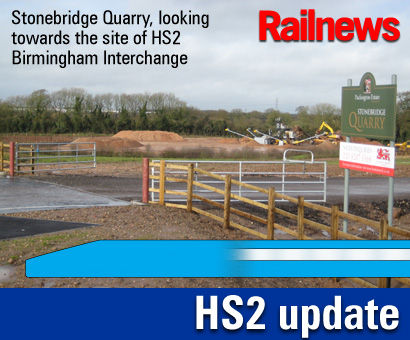A SMALL ceremony today in a Midlands barn means that David Higgins can publish his report on how to proceed with HS2 knowing that there are now firm plans for major regeneration projects around the HS2 stations planned at Euston, Old Oak Common, near Birmingham Airport, and in Birmingham city centre.
At Park Farm Barn, Meriden – part of Packington Estate, owned by Lord Aylesford – representatives of four land owners agreed today to work together for development of the new HS2 Interchange station and Solihull Metropolitan Borough Council’s ‘UK Central’ master plan – near the National Exhibition Centre, Birmingham Airport and the existing Birmingham International station.
According to the Greater Birmingham and Solihull Local Enterprise Partnership, UK Central “could create 100,000 jobs and boost GDP by as much as £19.5 billion.”
Earlier this week there was confirmation that London Mayor Boris Johnson is backing plans to create 24,000 new homes and more than 55,000 jobs at Old Oak Common.
This followed last week’s announcement by the principal landowner around Euston, Sydney & London Properties, of proposals for major redevelopment on 14.2 hectares at the London terminus – as earlier suggested by Chancellor of the Exchequer George Osborne – and Birmingham City Council’s ambitious Curzon Master Plan for extensive development of 141 hectares around the city centre’s HS2 terminal. This scheme includes creation of over 14,000 jobs, 600,000 square metres of new employment floor space and 2,000 new homes.
When he publishes his progress report on 17 March, David Higgins – who was awarded a knighthood for services to regeneration – will be able to point to these four big redevelopment projects, which will be attractive to private sector investors and would generate more than 150,000 new jobs, as further evidence of the benefits of HS2 and the need to get it built as quickly as possible.
There could be cost savings, too. For example, private sector redevelopment at Euston alone is already reported as likely to reduce the HS2 budget by £1.5 billion.
The site for the new Birmingham Interchange station and Solihull’s ‘UK Central’ comprises 101 hectares within a triangle bounded by the M42 Motorway and the A45 and A446/A452 roads. It is officially designated Green Belt but now has a gravel extraction quarry operating within it. As well as the Packington Estate, the landowners are Solihull Borough Council, Birmingham City Council and the Trustees of the Wingfield Digby Settled Estates.
Today their representatives signed a Memorandum of Understanding agreeing to “work jointly to ensure that the HS2 Interchange site is planned in such a way that will help deliver the wider economic growth and development that both central and local government is seeking, and as identified in the Solihull Metropolitan Borough Council vision document ‘UK Central’. In turn this is supported by the land owners and the Greater Birmingham and Solihull Local Enterprise Partnership.”
Solihull Councillor Ken Meeson said: “The HS2 Interchange will provide the connectivity which is at the heart of the high speed rail project. It will be the link with Birmingham City Centre, Birmingham Airport, the motorway network and mainline rail network for the West Midlands. It will also serve the proposed ‘UK Central’ development which is set to be one of the country’s largest economic development projects over the next decade.”
Packington’s Lord Charles Aylesford added: “The nation’s investment in high speed rail and the creation of Birmingham Interchange Station will provide many new opportunities for the local community. The Estate will work with Solihull MBC to ensure that the impact on the local environment and green belt are minimised.”


